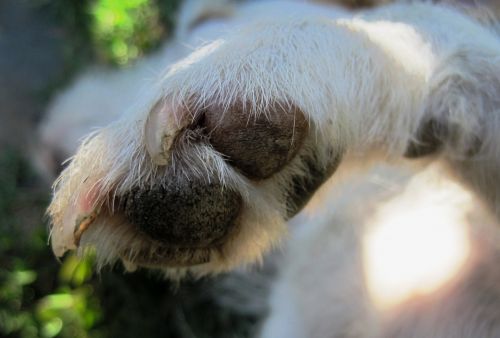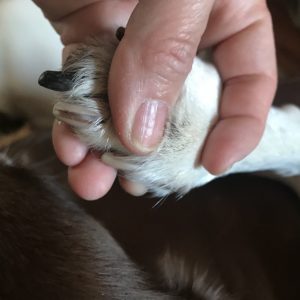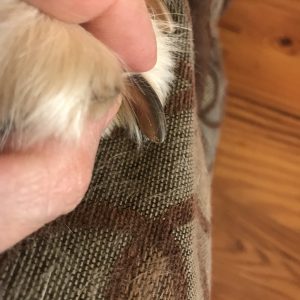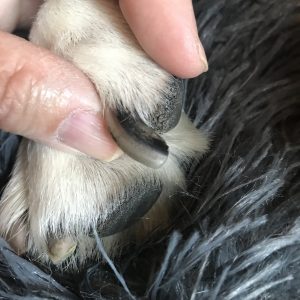Dog Nails Turning Brown or Red
If your dog’s nails are turning brown or red, it is most often a sign of a yeast infection[3].
Most yeast infections are due to allergy flare-ups. Infections associated with allergies can be the result of environmental, seasonal, and food sensitivities.
Yeast infections are often the result of excessive moisture from licking the affected area, especially paws and in between the pads.
Yeast infections are generally handled with topical therapies, including shampoos, mousse, and ointments.
If your pup suffers from chronic yeast infections from allergies, talk with your vet about appropriate medication to better manage your dog’s allergies to avoid future infections.

If your dog’s nails are turning white or you notice white lines in the nails, it is a condition called leukonychia[4].
Leukonychia is a condition that affects both dogs and humans and is typically the result of an injury to the nail bed.
The good news is, leukonychia is not a condition that requires medical treatment unless the nail itself shows signs of trauma such as a break or splitting (here’s what to do when your dog’s nail splits).
Keeping your dog’s nails short can help prevent leukonychia, even if they don’t want to let you cut their nails.
See Also: How to Sedate Your Dog to Trim Their Nails
What Your Dog’s Nail Color Means
Any unexpected changes in our dog’s appearance can be the cause of concern, primarily when the change occurs in their nails.
Changes to the color of your dog’s nails can mean anything from something benign, such as their normal pigmentation changing, to an infection that requires medical attention.
Over the years, my dog’s nails have changed in both color and density.
These changes occurred for a few different reasons, including age and disease.
Although every change in your dog’s nails isn’t cause for concern, it should be noted, and a call to your vet may be warranted.
Often early detection of an infection can save your dog a lot of pain and you a lot of time and money at the vet.
Dogs’ nails can change the whole nail color or just part of the nail.
Below are photos of my dogs’ nails.
The first photo is Calvin who has black nails, white nails and some with brown stripes. The one with the brown line will fade by summer.
It only happens during allergy season, but does not require direct treatment. Once his allergies are under control, it will return to normal.

The second photo is Sophie, her nails have thickened with age and have a reddish-brown tint.
Sophie suffers from allergies, Cushing’s disease, chronic pancreatitis, and IBD.
She does not have an infection; it is just a change that has slowly occurred over time as a result of age and health.

She is liver and white, but has black nails, white nails, and striped nails due to normal pigmentation, as seen below.

If you notice your dog’s nails turning black, it could be a sign of infection or a natural change due to your dog’s pigmentation.
If it is an infection, it could be either a fungal or bacterial infection[1], both of which are treatable.
One of the ways you identify that your dog has an infection versus a standard biological change is how they are acting.
When dogs have a nail infection:
Additionally, infections can impact one or more nails, depending on the severity.
If you suspect an infection, you will want to bring your dog to the vet to have the toenail checked.
There are various reasons dogs contract bacterial or fungal infections that impact their nails.
Infections may be the result of a minor scratch or abrasion or from parasites like ticks, fleas, and roundworms.
However, if your dog has a growth or tumor near the nail bed, that too may cause discoloration.
A lump near the nail bed may be a result of an infection or a mass of benign or malignant cells.
If your dog has a lump near their nail bed, it is essential to get your dog into the vet immediately to determine the cause.
Also, some lumps are the result of trauma, such as a foreign body under the skin, causing both irritation and infection.
After your vet has examined the nail, they will be able to determine the best course of action.
If your dog has an infection, topical and oral antibiotics will likely be used to resolve the issue.
However, if the condition is severe, the nail plate may require surgical removal to drain the infection[2].
Afterward, your vet may recommend soaking the foot in a medicated bath, topical ointments, and oral medications to ensure the infection is resolved.
However, if it is a tumor, your vet will recommend the appropriate steps.
Some may recommend removal, whereas other benign slow-growing lumps may only warrant observation.
If a foreign object causes the lump, it will need to be removed and cleaned so the toe can begin the healing process.
Dog NailsTurning Black

There could be different reasons for a dog nail to turnblack. One of them is the dog nail bed infections. Usually, claw infectionscaused by bacteria are responsible for making a dog nail black. However, a fungalinfection could also be the cause behind nail discoloration. In the case ofmild bacterial infections, topical antibiotics are used to treat the disease. However,your dog may require a course of oral antibiotics if the bacterial attack ismore severe.
Genetics is another reason due to which dog nails may turnblack. Some dog breeds have dual nail colors. Usually, they have white nails inpuppyhood but as they grow up, their nails start to turn black. Similarly, asemi-detached, dying nail may also become black. In these cases, there isabsolutely nothing to worry about as they are natural processes. Having saidthat, a sudden color change in nails should NEVER be taken lightly.
How to Trim Your Dog’s Nails at Home STEP BY STEP WITH TIPS
Are your dog’s nails looking a bit unusual? Do they seem to be licking at their paws or chewing at individual nails more than usual? If so, your pet may be exhibiting symptoms of a possible nail disorder or problem. Dog nail problems may come in many forms and symptoms, and can be related to a primary problem in the nails itself, or it may be a clue to a larger skin issue. Nails, after all, are an extension of the skin.
If more than one nail on a paw or more than one paw appears to be affected by malformed, broken, or sensitive nails, it may help to look at the bigger picture and determine what may be leading your pup’s nails to be unhappy.
The nail is a complicated and fascinating structure that is made up of thick keratin on the outside, with the function of protecting the softer structures on the inside, as well as the fingertip and nail bed region, from injury. Blood vessels and nerve supply are present deeper in the nail, and active cell division occurs beneath the cell surface to help a nail grow. If injured, the nail may take the brunt of the injury to protect underlying structures, and it will itself heal back in to shape nicely over time. Even with broken nails, good nail regrowth occurs in most cases with complete regeneration being common.
If you suspect your dog has issues with their nails, your dog may need to see your family veterinarian or a veterinary dermatologist, as nails are one of many things that a pet dermatologist specializes in diagnosing and treating. Following are some common presentations of nail-related problems in dogs.
A pet may exhibit more than one symptom at the same time. It’s very helpful for your veterinarian to hear all the symptoms being exhibited so that a reliable diagnosis and treatment plan can be made.
For example, a broken nail may be associated with pus like discharge, and the pet may be licking at it. In such a scenario, if only one nail appears affected, this could be a case of nail trauma leading to secondary infection that is causing the pus and increased licking (a form of itchiness) by the pet. On the other hand, if multiple nails were affected and there is presence of pus or crusting around them without itchiness, presence of an auto-immune condition (conditions where the body’s immune system may target/attack its own organ—such as nails!) or a fungal infection of the nails may be suspected. As you would expect, the nature of diagnostic testing and treatments for the 2 scenarios will be quite different.
Many conditions can lead to nail problems, and a complete evaluation of your dog will help determine what may be causing any kind of a nail disorder. Following is a brief list of possible causes for nail problems in dogs.